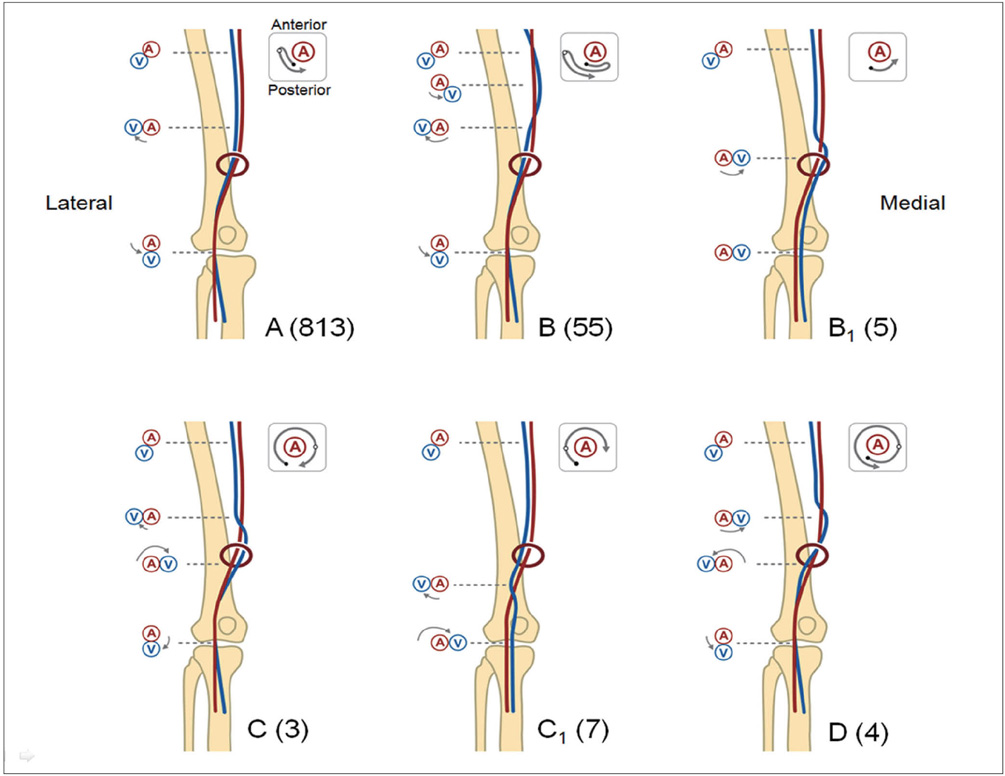Korean J Radiol.
2011 Jun;12(3):327-340. 10.3348/kjr.2011.12.3.327.
Three-Dimensional Evaluation of the Anatomic Variations of the Femoral Vein and Popliteal Vein in Relation to the Accompanying Artery by Using CT Venography
- Affiliations
-
- 1Department of Radiology and the Institute of Radiation Medicine, Seoul National University College of Medicine, Clinical Research Institute, Seoul National University Hospital, Seoul 110-744, Korea. chungjw@snu.ac.kr
- 2Department of Surgery, Seoul National University College of Medicine, Seoul National University Hospital, Seoul 110-744, Korea.
- KMID: 1122330
- DOI: http://doi.org/10.3348/kjr.2011.12.3.327
Abstract
OBJECTIVE
We wanted to describe the three-dimensional (3D) anatomic variations of the femoral vein (FV) and popliteal vein (PV) in relation to the accompanying artery using CT venography.
MATERIALS AND METHODS
We performed a retrospective review of 445 bilateral (890 limbs) lower limb CT venograms. After the 3D relationship between the FV and PV and accompanying artery was analyzed, the presence or absence of variation was determined and the observed variations were classified. In each patient, the extent and location of the variations and the location of the adductor hiatus were recorded to investigate the regional frequency of the variations.
RESULTS
There were four distinct categories of variations: agenesis (3 limbs, 0.3%), multiplication (isolated in the FV: 190 limbs, 21%; isolated in the PV: 14 limbs, 2%; and in both the FV and PV: 51 limbs, 6%), anatomical course variation (75 limbs, 8%) and high union of the tibial veins (737 limbs, 83%). The course variations included medial malposition (60 limbs, 7%), anterior rotation (11 limbs, 1%) and posterior rotation (4 limbs, 0.4%). Mapping the individual variations revealed regional differences in the pattern and frequency of the variations.
CONCLUSION
CT venography helps to confirm a high incidence of variations in the lower limb venous anatomy and it also revealed various positional venous anomalies in relation to the respective artery.
Keyword
MeSH Terms
-
Adolescent
Adult
Aged
Aged, 80 and over
Child
Contrast Media/diagnostic use
Female
Femoral Vein/anatomy & histology/*radiography
Humans
*Imaging, Three-Dimensional
Iohexol/analogs & derivatives/diagnostic use
Leg/*blood supply
Male
Middle Aged
Phlebography/*methods
Popliteal Vein/anatomy & histology/*radiography
Radiographic Image Interpretation, Computer-Assisted
Retrospective Studies
Tomography, X-Ray Computed/*methods
Figure
Cited by 1 articles
-
Fenestrated popliteal vein pierced by a branch of the tibial nerve
Edward C. Muo, Joe Iwanaga, Juan J. Cardona, Łukasz Olewnik, Aaron S. Dumont, R. Shane Tubbs
Anat Cell Biol. 2023;56(4):566-569. doi: 10.5115/acb.23.035.
Reference
-
1. Gordon AC, Wright I, Pugh ND. Duplication of the superficial femoral vein: recognition with duplex ultrasonography. Clin Radiol. 1996. 51:622–624.2. Kerr TM, Smith JM, McKenna P, Lutter KS, Sampson MG, Helmchen RH, et al. Venous and arterial anomalies of the lower extremities diagnosed by duplex scanning. Surg Gynecol Obstet. 1992. 175:309–314.3. Liu GC, Ferris EJ, Reifsteck JR, Baker ME. Effect of anatomic variations on deep venous thrombosis of the lower extremity. AJR Am J Roentgenol. 1986. 146:845–848.4. May R. Surgery of the legs and veins of the leg and pelvis. 1979. Philadelphia, PA: Saunders;4.5. Screaton NJ, Gillard JH, Berman LH, Kemp PM. Duplicated superficial femoral veins: a source of error in the sonographic investigation of deep vein thrombosis. Radiology. 1998. 206:397–401.6. Thomas ML. Phlebography of the lower limb. 1982. New York, NY: Churchill Livingstone;162–163.7. Dona E, Fletcher JP, Hughes TM, Saker K, Batiste P, Ramanathan I. Duplicated popliteal and superficial femoral veins: incidence and potential significance. Aust N Z J Surg. 2000. 70:438–440.8. Quinlan DJ, Alikhan R, Gishen P, Sidhu PS. Variations in lower limb venous anatomy: implications for US diagnosis of deep vein thrombosis. Radiology. 2003. 228:443–448.9. Uhl JF, Gillot C. Embryology and three-dimensional anatomy of the superficial venous system of the lower limbs. Phlebology. 2007. 22:194–206.10. Lee W, Chung JW, Yin YH, Jae HJ, Kim SJ, Ha J, et al. Three-Dimensional CT venography of varicose veins of the lower extremity: image quality and comparison with Doppler sonography. AJR Am J Roentgenol. 2008. 191:1186–1191.11. Byun SS, Kim JH, Kim YJ, Jeon YS, Park CH, Kim WH. Evaluation of deep vein thrombosis with multidetector row CT after orthopedic arthroplasty: a prospective study for comparison with Doppler sonography. Korean J Radiol. 2008. 9:59–66.12. Uhl JF, Gillot C, Chahim M. Anatomical variations of the femoral vein. J Vasc Surg. 2010. 52:714–719.13. Caggiati A, Bergan JJ, Gloviczki P, Eklof B, Allegra C, Partsch H. Nomenclature of the veins of the lower limb: extensions, refinements, and clinical application. J Vasc Surg. 2005. 41:719–724.14. Dodd H, Cockett FB. The pathology and surgery of the veins of the lower limb. 1976. 2nd ed. Edinburgh, Scotland: Churchill Livingstone;31–32.15. Quinn KL, Vandeman FN. Thrombosis of a duplicated superficial femoral vein. Potential error in compression ultrasound diagnosis of lower extremity deep venous thrombosis. J Ultrasound Med. 1990. 9:235–238.16. Rose SC, Zwiebel WJ, Miller FJ. Distribution of acute lower extremity deep venous thrombosis in symptomatic and asymptomatic patients: imaging implications. J Ultrasound Med. 1994. 13:243–250.17. Park EA, Lee W, Lee MW, Choi SI, Jae HJ, Chung JW, et al. Chronic-stage deep vein thrombosis of the lower extremities: indirect CT venographic findings. J Comput Assist Tomogr. 2007. 31:649–656.
- Full Text Links
- Actions
-
Cited
- CITED
-
- Close
- Share
- Similar articles
-
- A Giant Popliteal Artery Aneurysm Treated with Exclusion and Bypass Using a Saphenous Vein
- Transposition of Femoral Artery and Vein in Fossa Ovalis Encountered during Varicose Vein Surgery: 3 cases report
- A Popliteal Vein Aneurysm Causing Pulmonary Embolism
- Anatomical Variation of the Lesser Saphenous Vein
- Popliteal Artery Aneurysm Presenting as Acute Deep Vein Thrombosis










